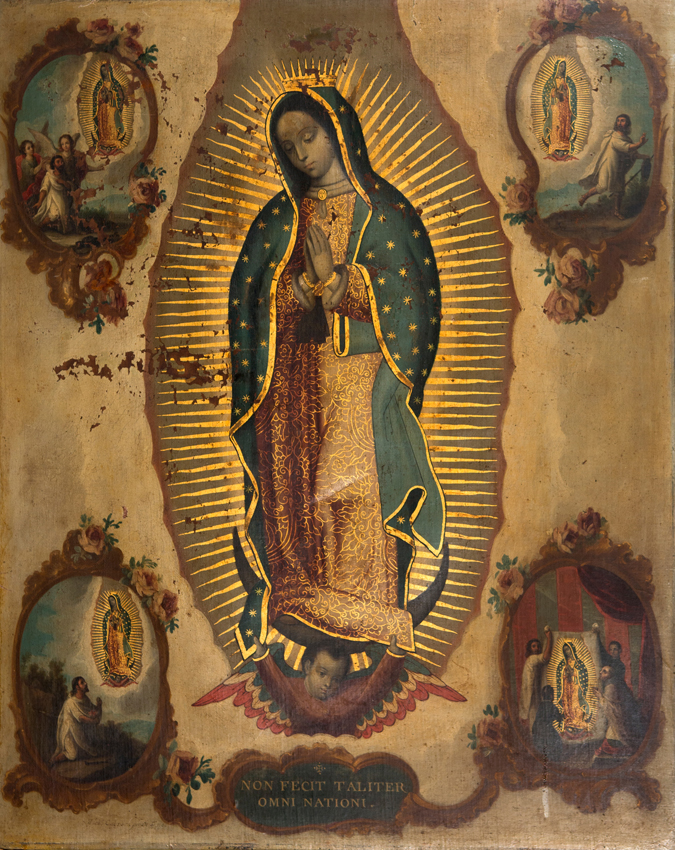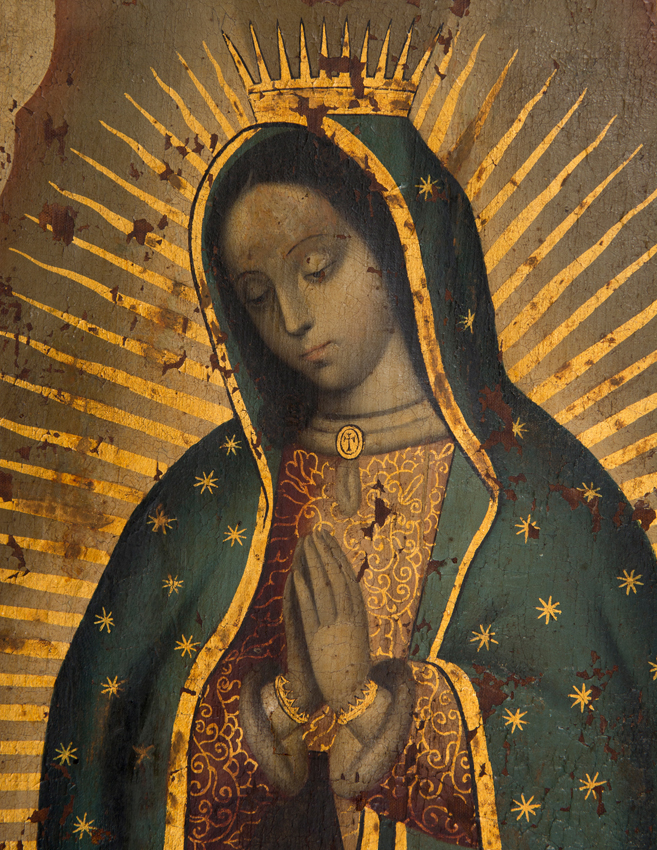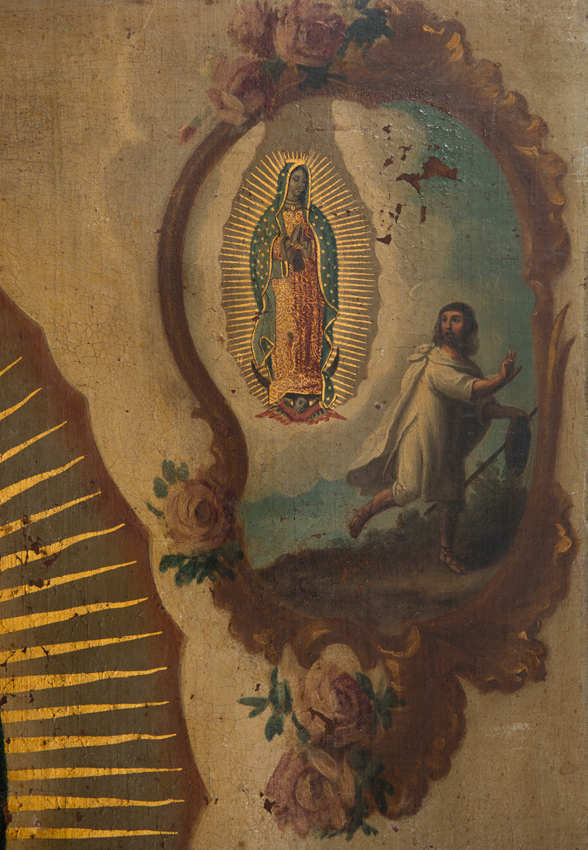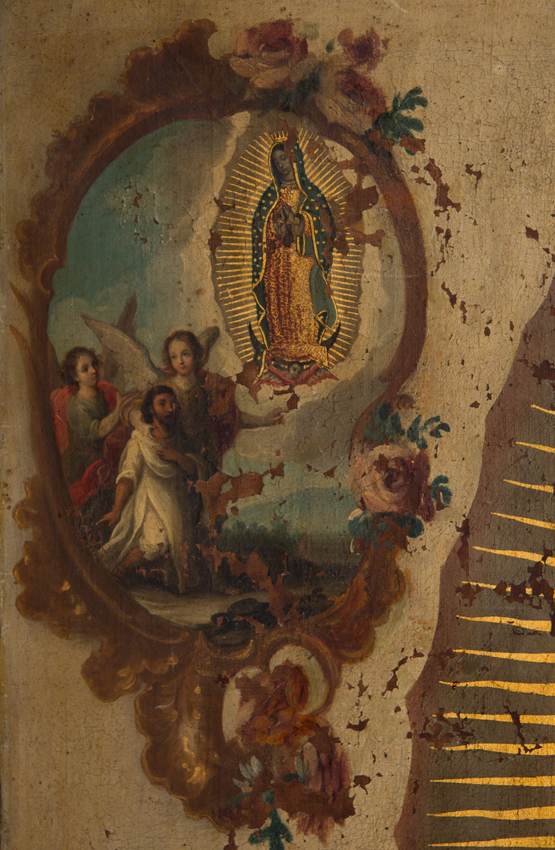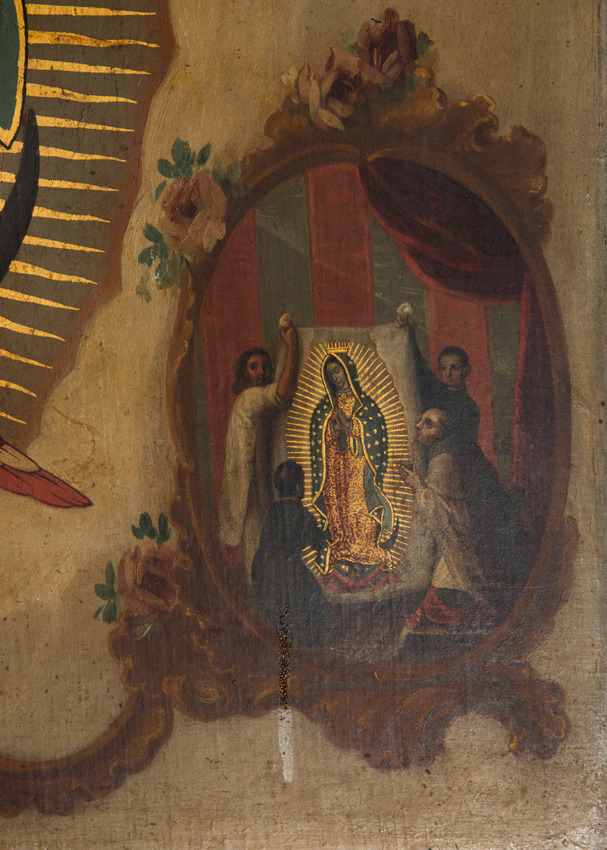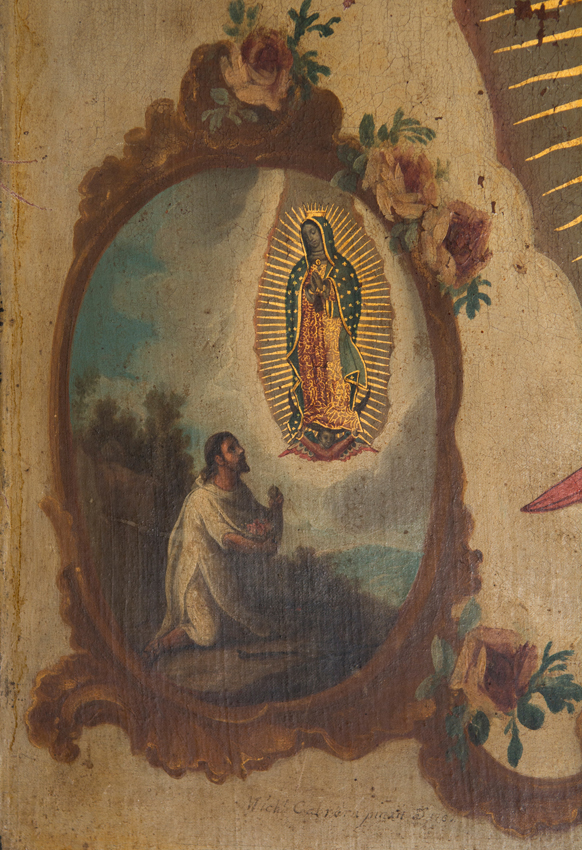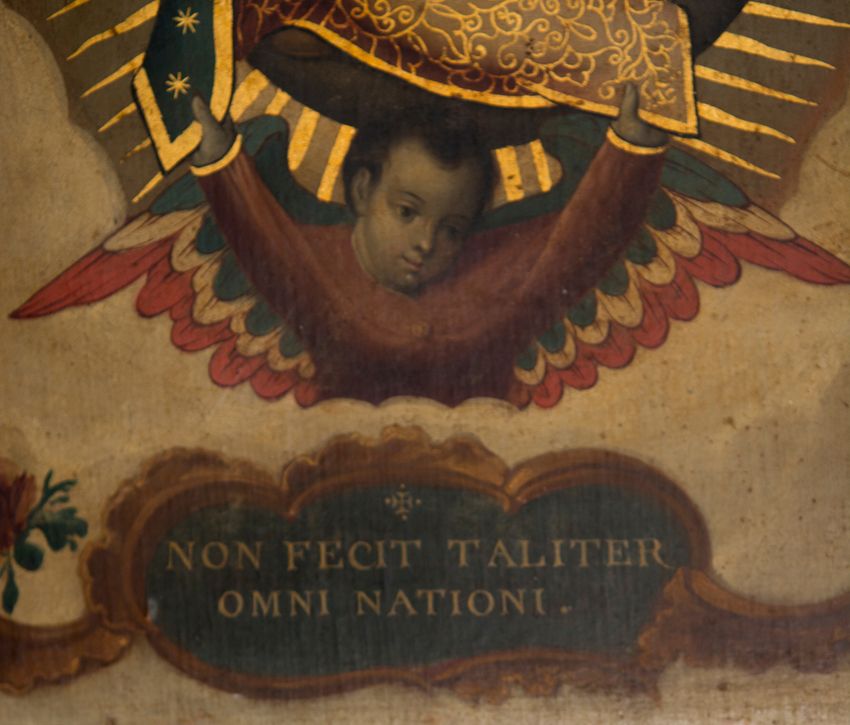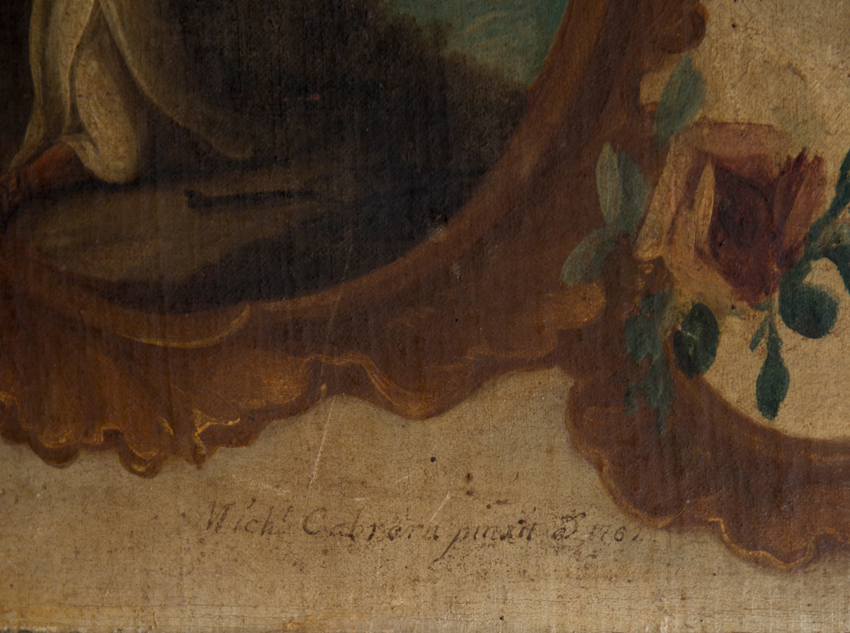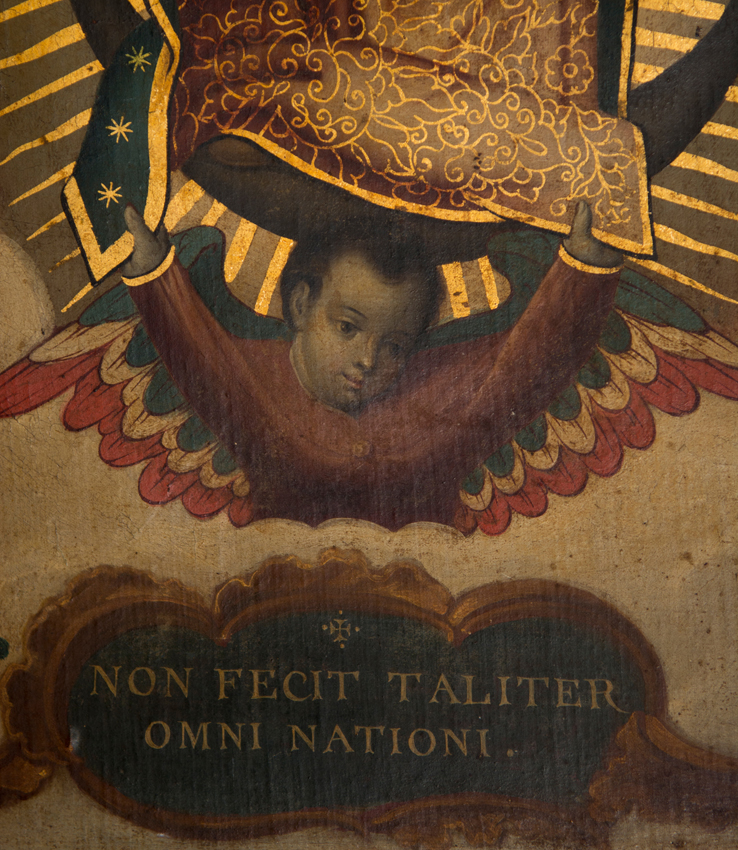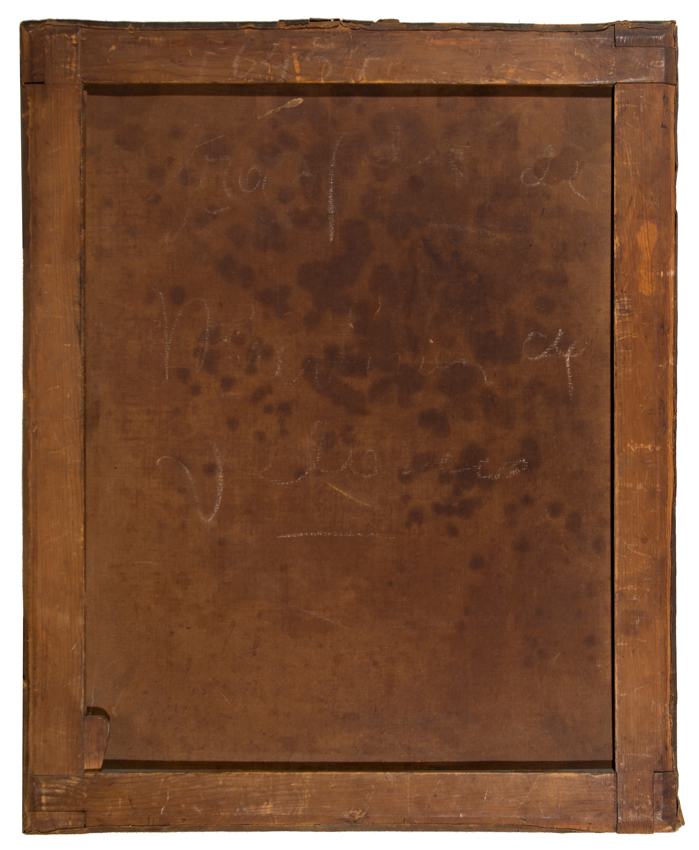36
Miguel Cabrera (Antequera de Oaxaca, Mexico, 1695 - Mexico, 1768)
Miguel Cabrera (Antequera de Oaxaca, Mexico, 1695 - Mexico, 1768)
"The Virgin of Guadalupe surrounded by the apparitions to the Indian Diego"
Oil on canvas. Signed and dated 1762.
87 x 70 cm.
Important representation of the Virgin of Guadalupe, which includes the apparitions and the Indian Juan Diego.
It has handwritten legend in Latin: "Non fecit taliter omni nationi" (He did nothing the same with any other nation) in reference to the words pronounced by Benedict XIV when he was presented with the image of the Virgin of Guadalupe and admiring its beauty, he approved the works of the Guadalupe patronage in Mexico.
Cabrera is considered the greatest exponent of 18th century Viceroyalty painting, with a production that the Dallas Museum of Art defines as "legendary: more than 309 works from his great studio have been documented".
Miguel Mateo Maldonado y Cabrera was born on February 27, 1695 in Antequera, present-day Oaxaca, Mexico, a fact known from the painter's will in 1768.
He was the son of unknown parents and godson of a mulatto couple. He moved to Mexico City in 1719, where he began his artistic training, passing through the workshop of Juan Correa in the capital of the Viceroyalty.
Cabrera painted altarpieces in the Jesuit church of Tepotzotlán, State of Mexico, in the church of Santa Prisca in Taxco, Guerrero and in the cathedrals of Mexico City and Puebla.
Cabrera was not only a painter, but he also participated in the attempt to found an academy of Arts in 1753 and in 1756 he was consecrated as an intellectual, not only as an artist, since he published a narration about the image of the Virgin of Guadalupe in 1756 entitled "Maravilla americana y conjunto de raras maravillas observadas con la dirección de las reglas del arte de la pintura", a narration about the image of the Virgin Guadalupe in the printing press of the Jesuit college of San Ildefonso.
In addition to easel painting, his production includes the design of altarpieces, large format works, as well as small copper works and nun's shields. Cabrera's religious painting produces figures of remarkable beauty, a beauty understood under the ideological assumptions of the devotion of the time. It is a refined art that possesses a well-arranged chromatic richness, is sustained by a great work of composition and, no less important, a subtle and expressive drawing.
Of all the painters of that time, Cabrera was the one with the greatest personality; the conventional treatment in his figures was undoubtedly the basis of his way of painting, because he placed in his paintings models that were not ideal, but corresponded to people that the artist knew and treated, as when he incorporated in some paintings, portraits of donors or the so-called "prelates" because he had the need to observe directly and copy from nature. He was appointed chamber painter of Archbishop Manuel Rubio y Salinas, who commissioned him to study and paint the image of Our Lady of Guadalupe, reproducing the ayate. The image was sent to Pope Benedict XIV, from whom he obtained the highest recognition as a painter of Guadalupe. Among the portraits he painted, the one of Sor Juana Inés de la Cruz, kept in the National Museum of History, and the one of Juan de Palafox y Mendoza, located in the Museum of Colonial Art in Morelia, Michoacán, Mexico.
He was also a painter for the Society of Jesus, for whose churches he produced numerous works.
In 1753 he was named president for life of the Academy of San Carlos.His work is preserved in many churches and convents in Mexico.It is also present in numerous public and private collections.Two of his images of the Virgin of Guadalupe are in the Vatican Museum.Another, made in 1756, for the temple of San Francisco Javier, is preserved in the National Museum of the Viceroyalty.The Museum of Art of Dallas, conserves a Santa Gertrudis La Magna by Miguel Cabrera and another representation of the Saint, also by Cabrera and dated in 1768, is part of the collection of the Museum José Luis Bello y Zetina of Puebla, Mexico.
Likewise, we highlight an important series of the Caste paintings of 1763 that is conserved in the collection of the Museum of America in Madrid. They depict families, father, mother and child of the various castes and social strata, in everyday life situations. Finally, mention should also be made of the Pinacoteca de La Profesa or the Andrés Blaisten Collection in Mexico, as depositories of Cabrera's work.
The Museum of America in Madrid is currently exhibiting a very important retrospective of the painter.
Miguel Cabrera (Antequera de Oaxaca, Mexico, 1695 - Mexico, 1768)
"The Virgin of Guadalupe surrounded by the apparitions to the Indian Diego"
Oil on canvas. Signed and dated 1762.
87 x 70 cm.
Important representation of the Virgin of Guadalupe, which includes the apparitions and the Indian Juan Diego.
It has handwritten legend in Latin: "Non fecit taliter omni nationi" (He did nothing the same with any other nation) in reference to the words pronounced by Benedict XIV when he was presented with the image of the Virgin of Guadalupe and admiring its beauty, he approved the works of the Guadalupe patronage in Mexico.
Cabrera is considered the greatest exponent of 18th century Viceroyalty painting, with a production that the Dallas Museum of Art defines as "legendary: more than 309 works from his great studio have been documented".
Miguel Mateo Maldonado y Cabrera was born on February 27, 1695 in Antequera, present-day Oaxaca, Mexico, a fact known from the painter's will in 1768.
He was the son of unknown parents and godson of a mulatto couple. He moved to Mexico City in 1719, where he began his artistic training, passing through the workshop of Juan Correa in the capital of the Viceroyalty.
Cabrera painted altarpieces in the Jesuit church of Tepotzotlán, State of Mexico, in the church of Santa Prisca in Taxco, Guerrero and in the cathedrals of Mexico City and Puebla.
Cabrera was not only a painter, but he also participated in the attempt to found an academy of Arts in 1753 and in 1756 he was consecrated as an intellectual, not only as an artist, since he published a narration about the image of the Virgin of Guadalupe in 1756 entitled "Maravilla americana y conjunto de raras maravillas observadas con la dirección de las reglas del arte de la pintura", a narration about the image of the Virgin Guadalupe in the printing press of the Jesuit college of San Ildefonso.
In addition to easel painting, his production includes the design of altarpieces, large format works, as well as small copper works and nun's shields. Cabrera's religious painting produces figures of remarkable beauty, a beauty understood under the ideological assumptions of the devotion of the time. It is a refined art that possesses a well-arranged chromatic richness, is sustained by a great work of composition and, no less important, a subtle and expressive drawing.
Of all the painters of that time, Cabrera was the one with the greatest personality; the conventional treatment in his figures was undoubtedly the basis of his way of painting, because he placed in his paintings models that were not ideal, but corresponded to people that the artist knew and treated, as when he incorporated in some paintings, portraits of donors or the so-called "prelates" because he had the need to observe directly and copy from nature. He was appointed chamber painter of Archbishop Manuel Rubio y Salinas, who commissioned him to study and paint the image of Our Lady of Guadalupe, reproducing the ayate. The image was sent to Pope Benedict XIV, from whom he obtained the highest recognition as a painter of Guadalupe. Among the portraits he painted, the one of Sor Juana Inés de la Cruz, kept in the National Museum of History, and the one of Juan de Palafox y Mendoza, located in the Museum of Colonial Art in Morelia, Michoacán, Mexico.
He was also a painter for the Society of Jesus, for whose churches he produced numerous works.
In 1753 he was named president for life of the Academy of San Carlos.His work is preserved in many churches and convents in Mexico.It is also present in numerous public and private collections.Two of his images of the Virgin of Guadalupe are in the Vatican Museum.Another, made in 1756, for the temple of San Francisco Javier, is preserved in the National Museum of the Viceroyalty.The Museum of Art of Dallas, conserves a Santa Gertrudis La Magna by Miguel Cabrera and another representation of the Saint, also by Cabrera and dated in 1768, is part of the collection of the Museum José Luis Bello y Zetina of Puebla, Mexico.
Likewise, we highlight an important series of the Caste paintings of 1763 that is conserved in the collection of the Museum of America in Madrid. They depict families, father, mother and child of the various castes and social strata, in everyday life situations. Finally, mention should also be made of the Pinacoteca de La Profesa or the Andrés Blaisten Collection in Mexico, as depositories of Cabrera's work.
The Museum of America in Madrid is currently exhibiting a very important retrospective of the painter.
Viceregal Masters. Allegories, legends and sanctity.
Sale Date(s)
Venue Address
General delivery information available from the auctioneer
The purchase price includes the delivery of the lots in the venue of the auction. Transporting to other destinations is at the own risk of the client. The customer must contact "LST", to give the corresponding instructions for such transporting. "LST" is not responsible for the packaging or any accident incurred during transportation.
Important Information
Zu Aufgeld und Mehrwertsteuer prüfen Sie bitte das jeweilige Los.
For premiums and taxes please refer to the particular lot.
Terms & Conditions
CONDITIONS OF THE AUCTION:
I. REGISTRATION. To bid in the room customers must register at the beginning, filling out a form and picking a number that will identify them during the auction. Customers may be required to register in bank references or other guarantee system and if they do not prove the solvency "LST" will not accept bids and award the auction.
II. WRITTEN BIDS. "LST" will accept written bids, which will be formalized in the form provided by the room until the day before the auction. In such auctions, the room will bid in name of the client until the maximum stated in the offer and always at the lowest possible price. If there are two or more bids for the same amount, the one placed first will have the priority. Written bids received in advance, will have priority on the day of the auction.
III. TELEPHONE BIDS. "LST" will allow telephone bids, if interested people contact "LST" days before the auction providing personal data, ID card and the phone number which will be used by the staff of "LST" to call at the time of the auction. The buyer, within all the legal rights is making an offer for the asking price, when applies for telephone bid. "LST" will not take responsibility for any technical defects beyond its control, which may prevent to contact successfully the bidder during the auction.
IV. AUCTIONEER. The auction will be conducted by an auctioneer, director of the auction will be judge and arbitrator of it with full authority in its development, will award the lots to the highest bidder and is able to settle any controversy concerning lots sale, reject bids, divide lots or group them and remover objects from the room. Will be able to, if it is deemed suitable, not accept bids on the auction. His decision will be unappealable.
V. SALE OF LOTS. The lots are awarded to the highest bidder. Once the auctioneer blows the hammer, the buyer becomes responsible of the lot purchased, exempting "LST" of liability to for any damage and / or accidents that may occur. No refunds of lots.
VI. STARTING PRICE. The amount shown in the catalogue as the starting price for each lot will be, as a rule, the minimum selling price, except for exceptional cases where a reservation may be agreed upon with the seller or it set discretionary by the room.
VII. SCALE OF BIDS. The bids are set according to the following scale:
From 50.-€ to 200.-€…………………………………………..at 10.-€
From 200.-€ to 500.-€…………………………………… …25 in 25.-€
From 500.-€ to 1.000.-€………………………………..…..….50 in 50.-€
From 1.000.-€ to 2.000.-€………………………………..…100 in 100.-€
From 2.000.-€ to 5.000.-€……………………………….….250 in 250.-€
From 5.000.-€ to 10.000.-€…………………………………500 in 500.-€
From 10.000.-€ to 20.000.-€……………………………1.000 in 1.000.-€
From 20.000.-€ to 50.000.-€……………………………2.500 in 2.500.-€
From 50.000.-€ to 100.000.-€…………………………..5.000 in 5.000.-€
From 100.000.-€ to 100.000.-€………………………10.000 in 10.000.-€
From 200.000.-€ to 200.000.-€………………………25.000 in 25.000.-€
From 500.000.-€ to 500.000.-€………………………50.000 in 50.000.-€
VIII. RIGHT OF ADMISION. "LST" reserves the right to admission to the auction room and to reject, at its judgment, any purchase order, from clients whose solvency is not duly proved as well as not to sale auctions.
IX. SALE PRICES. The successful bidder of one or more lots must pay "LST" the final sale price achieves at auction, plus the 24,5 % plus 21% VAT on the commission, at total 29,64 % on Hammer Price.
X. CATALOG DATA. The catalogue data are obtained in order to careful research and advice, however, any responsibility is afforded about its accuracy. The lots will be auctioned in the state in which they are, not accepting any claims in restorations, breakage, damage, imperfections and, even description or numbering mistakes in the catalogue, in case of it, being the burden of the buyers to make sure before the auction that the description matches with their personal opinion about respective lot. The exhibition of the lots is intended to allow a perfect review and study of them.
XI. PAYMENT AND REMOVAL OF LOTS. Payment and removal of the lots will be held no later than five days following the auction. After this period expire without having the buyer removed the lot or lots purchases, it will accrue an expense of custody of 6 euros per day on each lot.
15 days after the auction without having the buyer paid and removes the sold lots, "LST" will inform the seller and there will begin judicial proceeding in order to obtain payment. The delay in payment by the purchaser of his/her sold lots will carry an interest increase at a rate of 1,5% per month.
XII. DELIVERY OF LOTS. The purchase price includes the delivery of the lots in the venue of the auction. Transporting to other destinations is at the own risk of the client. The customer must contact "LST", to give the corresponding instructions for such transporting. "LST" is not responsible for the packaging or any accident incurred during transportation.
XIII. RIGHT OF FIRT REFUSAL AND REPURCHASE. "LST" in order to article 38 of "Ley 16/1985 de 25 Junio del Patrimonio Histórico Español" (BOE. 155 June 29, 1985), will notify in advance to the Ministry of Culture, the content of their catalogues. Concerning the lots subject to the legislation referred to in the preceding paragraph, the Administration may exercise the rights of first refusal and repurchase according to the law. "LST" will watch over the protection of Artistic, Historical and Bibliographical Heritage of Spain. For customers out of European Community, a tax for export is required by the Administration.
XIV. VALUE ADDED TAX (I.V.A). This tax will be accrued on commissions of "LST" for buyers, using the rates prevailing on the date of the auction.
XV. DATA PROTECTION. In order to the "Ley 15/1999 de 13 de Diciembre, de Protección de Datos de Carácter Personal", the client authorize "LST", the inclusion of their data in a customer file, and for the promotion by "LST" of the objects at all times the rights of access, rectification or deletion of personal data by sending the appropriate request to the following address: LA SUITE SUBASTAS, C/ Conde Salvatierra, 8, 08006. Barcelona.
XVI. EXPRESS LEGAL JURISDICTION. These Conditions are governed by and interpreted in accordance with the rules of Spanish law. The mere act of participating in the auction as seller, buyer or bidder, implies acceptance of these Terms and Conditions.
Sales operations are understood to be held at the registered office of "LST", C/ Conde de Salvatierra, 8, 08006. Any dispute shall be taken to the competent courts of Barcelona, expressly waiving any other jurisdiction, in accordance with Article 55 of the "Ley de Enjuiciamiento Civil".
























